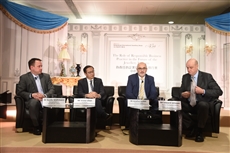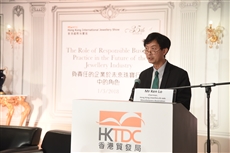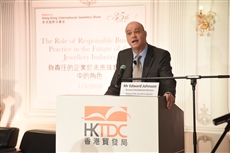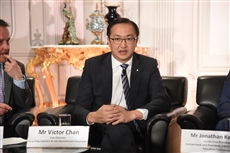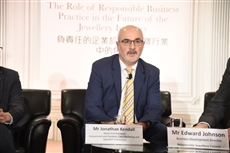How Generation Z, Social Media and Mobile Technology are Transforming the Jewellery Industry
7 March 2018 – Among the events staged during the recently concluded HKTDC Hong Kong International Diamond, Gem and Pearl Show (27 February-3 March) and Hong Kong International Jewellery Show (1-5 March) was a panel discussion on the future of ethical business practices in the jewellery industry, organised by the Hong Kong Trade Development Council (HKTDC).
Moderated by the Responsible Jewellery Council (RJC), an international not-for-profit standards and certification organisation, “The Role of Responsible Business Practice in the Future of the Jewellery Industry” featured moderator Edward Johnson, RJC’s Business Development Director, along with Victor Chan, Hong Kong Jewellery & Jade Manufacturers Association Vice Chairman and Chairman of Continental Holdings Ltd; Dr Guido Grohmann, BV Schmuck + Uhren Managing Director; and Jonathan Kendall, Forevermark Senior Vice president and CIBJO Marketing and Education Commission President.
Introducing RJC’s work around the world, Mr Joyce said RJC is setting standards in the jewellery supply chain, from mining to retail, to strengthen consumer confidence in the jewellery trade. To date, RJC counts more than 1,000 members, 726 of which are certified, covering 455,136 employees, 8,887 business premises in 75 countries.
In his welcoming remarks, Ken Lo, Chairman of the Hong Kong Jewellery & Jade Manufacturers Association noted that the Hong Kong body established links with the RJC in 2013, and became a member in 2015.
Synthetic and Simulant Gems are the Biggest Threat to the Industry
The panellists began discussions by identifying what they considered the biggest challenges in the industry. Mr Kendall said that synthetic and simulant gems are the biggest threat and will remain so in the future. He said that synthetic and simulant stones can infiltrate any part of the supply chain, that even one sale would be one too many. The industry has sought to tackle the problem, particularly during the last year, including by distributing testing machines to both manufacturers and retailers.
Dr Grohmann said the biggest challenge for Germany’s jewellery and watch industry is keeping up with European legislation and around the world that have a direct impact on their business. Dr Grohmann noted that the vast majority of jewellery businesses in Germany were small to medium-sized and lacked the manpower to keep abreast of legislation, particularly in the areas of data privacy and money-laundering. Dr Grohmann added that membership in a body such as RJC, which offers legal support, helps smaller companies to mitigate the problem.
Mr Chan said that corporate social responsibility (CSR) in the jewellery industry in China was a challenge as the country still lacked formalised CSR initiatives that are found in the West. However, he added that CSR is becoming an important issue in China and is moving in the right direction, largely driven by consumers who want more sustainable suppliers. Mr Chan said that the environment is becoming a bigger policy concern for the Chinese government, but that given the country’s size, it would be more effective for local industry bodies, with the help of RJC, to start their own initiatives.
Employees are the Key Communication Bridge to Consumer on Responsible Jewellery
The panel also discussed promoting the importance of responsible jewellery manufacturing and retail to consumers, with Mr Chan noting that employees serve as the key communication channel. He said that when his company joined RJC, employees initially questioned the wisdom of the membership, but eventually saw the value of RJC’s work after seeing improvements in standards and product quality. Mr Chan said that employees then started relaying directly to consumers their own experience with supply chain integrity.
Mr Kendall said communicating responsible business practices is paramount amid greater consumer scrutiny of jewellery products. Mr Kendall added that consumers today want to know where stones are mined, cut and polished, a trend that the industry must embrace. Mobile phones have dramatically changed consumer behaviour, Mr Kendall said, creating a relationship between the consumer and the production pipeline that did not exist 10 or 15 years ago. To allay consumer concerns, cameras may eventually be brought into mines to document the process, allowing buyers to check on the gem’s provenance and obtain immediate answers.
Radical Transparency Becomes a Defining Issue in the Jewellery Business
The discussion wrapped up with a look towards the future and the most pressing challenges facing the jewellery industry, particularly as responsible business practices increasingly come to the fore. All of the panellists agreed that transparency, even radical transparency, would become a defining issue in the jewellery business.
Mr Kendall said that the industry needs to start considering the purchasing behaviour of Generation Z, the post-millennial generation, who are currently aged 15 to 20 years old. Citing research by Forevermark, Mr Kendall said Generation Z exhibit a strong affinity to social media, are technologically sophisticated, strong communicators, risk-averse and have an interest in the environment, ethical business practices and the “greater good.” These traits make it vitally important for the jewellery industry to adopt more ethical and transparent practices to satisfy the next generation of consumers, Mr Kendall said.
Mr Chan echoed similar sentiments, adding that the world has become smaller with rapid improvements in the Internet and technology, which will lead consumers to seek more information, not only on jewellery but on all the products they buy.
Dr Grohmann also agreed that the next generation of consumers will be more interested and invested in responsible business practices. He added that language and distance were no longer barriers to checking the supply chain. Dr Grohmann added that the industry need to be mindful that the dominance of social media meant that companies that fall foul of ethical behaviour will face huge problems within minutes due to viral boycotts on Twitter and Facebook.
|
|
“The Role of Responsible Business Practice in the Future of the Jewellery Industry” panel discussion was held on the first day (1 March) of the Hong Kong International Jewellery Show |
|
|
Ken Lo, Chairman, Hong Kong Jewellery & Jade Manufacturers Association |
|
|
Edward Johnson, Business Development Director, Responsible Jewellery Council |
|
|
Victor Chan, Vice Chairman, Hong Kong Jewellery & Jade Manufacturers Association and Chairman, Continental Holdings Ltd |
|
|
Dr Guido Grohmann, Managing Director, BV Schmuck + Uhren |
|
|
Jonathan Kendall, Senior Vice President, Forevermark and Marketing and Education Commission President, CIBJO |
Fair Website:
Hong Kong International Diamond, Gem and Pearl Show: http://hkdgp.hktdc.com/
Hong Kong International Jewellery Show: http://hkjewelleryshow.hktdc.com/
Enhanced Security Measures for Buyers: http://hkjewellery.hktdc.com/pdf/2018/Important Notice/Enhanced_security_measures_(ENG).pdf
Media Enquiries
Please contact the HKTDC's Communications & Public Affairs Department:
Agnes Wat Tel: (852) 2584 4554 Email: agnes.ky.wat@hktdc.org
Sunny Ng Tel: (852) 2584 4357 Email: sunny.sl.ng@hktdc.org
To view press releases in Chinese, please visit http://mediaroom.hktdc.com/tc
About the HKTDC
Established in 1966, the Hong Kong Trade Development Council (HKTDC) is a statutory body dedicated to creating opportunities for Hong Kong’s businesses. With more than 40 offices globally, including 13 on the Chinese mainland, the HKTDC promotes Hong Kong as a platform for doing business with China, Asia and the world. With 50 years of experience, the HKTDC organises international exhibitions, conferences and business missions to provide companies, particularly SMEs, with business opportunities on the mainland and in international markets, while providing information via trade publications, research reports and digital channels including the media room. For more information, please visit: www.hktdc.com/aboutus.


